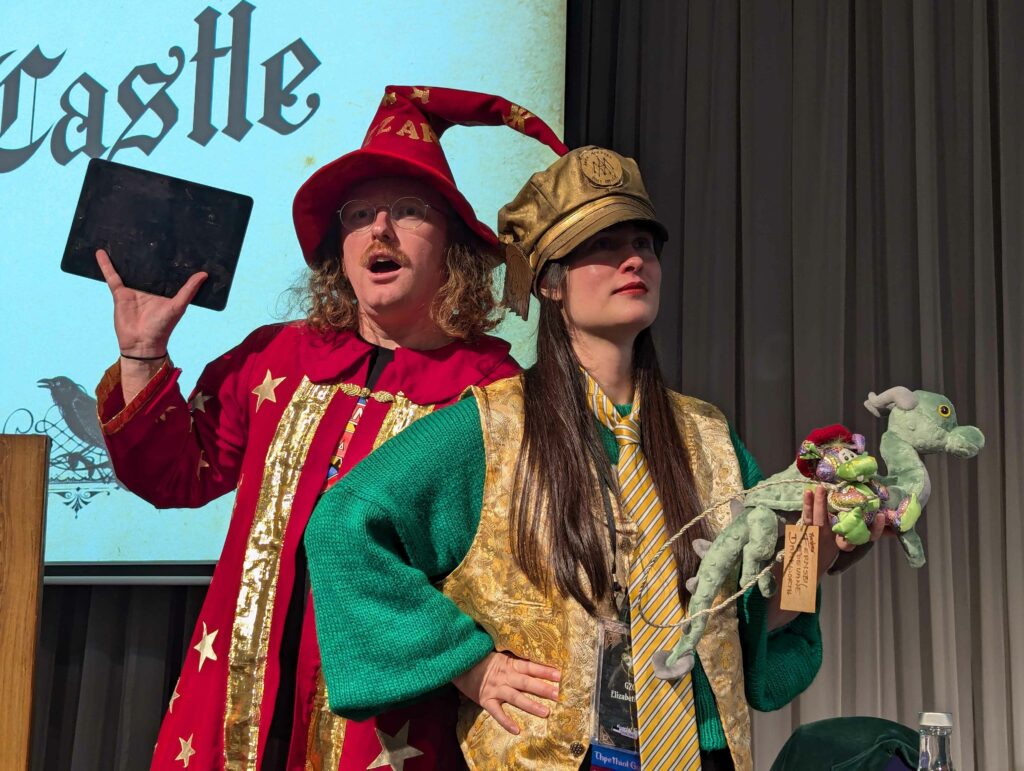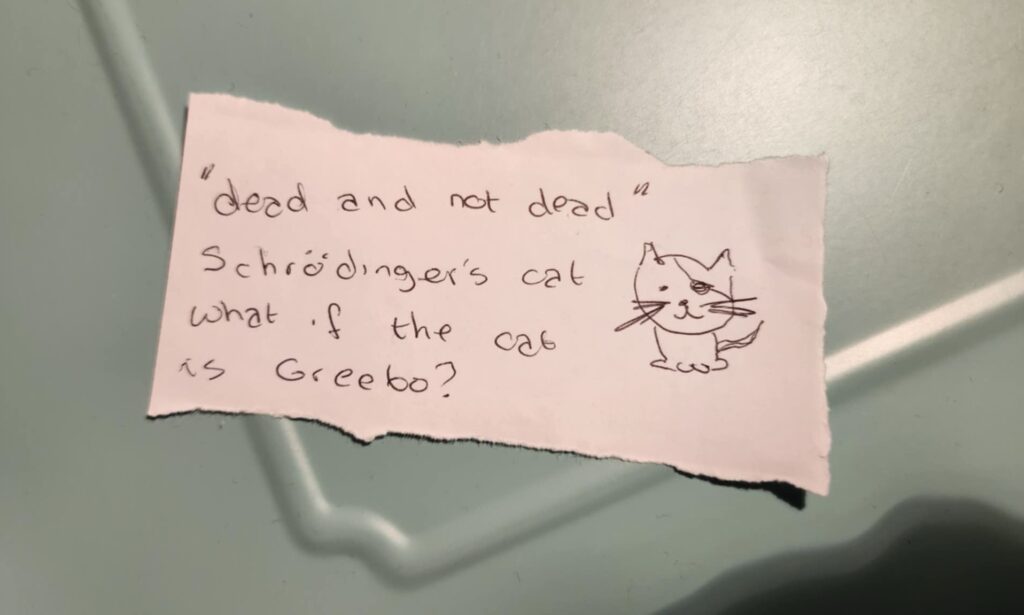#Pratchat38 Notes and Errata
These are the show notes and errata for episode 38, “Moisten to Steal“, featuring guests Nicholas J Johnson and Lawrence Leung, discussing the 33rd Discworld novel, and the first to feature Moist von Lipwig, 2004’s Going Postal.
Iconographic Evidence
- David Lynch’s 1984 film adaptation of Frank Herbert’s novel Dune is famous for many things. One of them is British singer Sting’s supporting role as Feyd-Rautha, sadistic nephew of the evil Baron Harkonnen. He is introduced stepping out from jets of steam wearing only a pair of winged metal underpants, as captured in this gif:

Notes and Errata
- The episode title plays on the phrase used to refer to envelopes you have to lick in order to seal them – “moisten to seal”.
- Ben is actually thinking of the music video (or “film clip” as he calls it) for Michael Jackson’s “Beat It”, the third single from Jackson’s 1982 album Thriller. The dance fight in question takes place during the guitar solo, and you can see it on YouTube here. (You can also see a parody of it in the music video for Weird Al Yankovic’s “Eat It”.)
- Though the first editions of The Colour of Magic were published by Colin Smythe in 1983, it likely wasn’t available in Australia until the release of the Corgi paperback edition in 1985. This isn’t easy to verify though, so if you have any information on this, let us know!
- We’ve previously discussed all three books in the Book of the Nomes trilogy, aka “The Bromeliad”: Truckers, Diggers and Wings.
- We’ve also covered all three of the Johnny Maxwell books: Only You Can Save Mankind, Johnny and the Dead and Johnny and the Bomb.
- We discussed Guards! Guards! with Aimee Nichols back in #Pratchat7A, “The Curious Incident of the Dragon and the Night Watch“.
- We discussed Mort all the way back in our second episode, #Pratchat2, “Murdering a Curry“.
- The Terminator is the titular protagonist of James Cameron’s 1984 science fiction film The Terminator. Arnold Schwarzenegger starred as the Terminator, a cyborg sent back in time by the artificial intelligence Skynet to kill Sarah Connor (Linda Hamilton). By doing so it hopes to alter the future in which her unborn son leads a resistance movement against Skynet’s machine army. The film was a success, and its direct sequel Terminator 2: Judgment Day (1991) even more so, resulting in a franchise of comics, novels, games, a TV series (The Sarah Connor Chronicles starring Lena Heady) and three further feature films. Cameron himself was only directly involved with the most recent film sequel, 2019’s Terminator: Dark Fate, which while getting the best critical response of the later films made the least money. Schwarzenegger appears in nearly all of the films as a version of the Terminator, creating an iconic character with his deadpan delivery.
- Several news outlets, including The Guardian, reported in September 2020 that Australia Post management asked its office workers to volunteer to deliver mail – in their own cars – to help clear a backlog of deliveries.
- The Clacks first appear in 1999’s The Fifth Elephant (discussed in #Pratchat40, “The King and the Hole of the King“), forming an important part of the plot. By the time of that book, semaphore towers have proliferated across Ankh-Morpork. The Watch seem to have their own system, but the Clacks stretches as far as Überwald and has caught on quickly since its invention. The Grand Trunk company does not yet have a monopoly on the system, though a trunk to Genua is being planned. It may also be the Dearheart system was just so superior that it outperformed all rivals, though it is more likely from the description of Gilt and his cronies’ business tactics that they bought up any competitors after they took over the company.
- On Roundworld (i.e. our world), the earliest kind of semaphore tower first appeared around the 4th century BCE in Greece. Rather than a symbolic system of flags or lights, they used vessels of water which were emptied for an amount of time indicated by the sender through torch signals. The water would run out until it reached the level marked with the message the sender wanted to transmit. The more modern kind of tower, which resembles the Clacks, was the optical telegraph, inspired by military semaphore of the time – see the note below.
- Le Comte de Monte-Cristo (in English, The Count of Monte Cristo) is a French serialised adventure novel written by Alexandre Dumas (1802-1870) and first published between 1844 and 1846. The hero, honest sailor Edmond Dantès, is on his way home to marry his fiancée in 1815 when he is framed as a traitor and sentenced to imprisonment in an island fortress. There he is mentored by a fellow prisoner, who helps him identify the three men who betrayed him. Dantès escapes, and secures the hidden treasure belonging to his mentor, but ignores his advice and uses it to seek revenge, disguised as “the Count of Monte Cristo”. One of his revenge plots includes Dantès bribing the poorly paid operator of an optical telegraph tower to send a false message, which is picked up by an official and passed indirectly to the Count’s victim.
- There have been multiple versions of the optical telegraph. The best-known is the French system created by engineer Claude Chappe for the Revolutionary government in 1793, which is the one appearing in Dumas’ novel. Inspired by naval semaphore flags, Chappe created a system of pulleys that moved one large beam with a smaller rotating beam on each end; these could be quickly moved into many different shapes. He also devised the code used by the telegraph, and a set of rules for its operation, so he would likely have got along well with the crackers of the Smoking Gnu! The Clacks grid of shutters is probably mostly based on the system invented by Lord George Murray for the British admiralty in 1795, though this was superseded in 1816 by the simpler and easier to see system invented by Sir Home Popham.
- Channel 4 sitcom The IT Crowd is set in the IT department of Reynholm Industries, where nerds Moss (Richard Ayoade) and Roy (Chris O’Dowd) end up with a new manager, Jen (Katherine Parkinson), who knows nothing about computers. It ran for four series from 2006 to 2010, plus a double-length finale in 2013. In the episode “The Speech” from series 3, Jen makes Roy and Moss write her an acceptance speech for an award; they decide to embarrass her by convincing her that a small black box with a blinking light is “the Internet”.
- ADSL is a type of Digital Subscriber Line, a technology allowing fast transfer of digital information over old copper telephone lines by using frequencies not used by standard voice communication. The A stands for Asymmetric – ADSL provides a much faster speed for downloads than for uploads. Because there may be a great deal of noise on the line, depending on the gauge and quality of the copper network, ADSL is not suited to long-distance use so it is only deployed for up to a few kilometres from an exchange – and you are likely to get less noise over shorter distances, so if you’re closer to the exchange your signal will be clearer and consequently your speeds will be faster.
- The Sting is a 1973 film directed by George Roy Hill and starring Paul Newman and Robert Redford. It won a slew of Oscars in 1973 and was so influential that according to Nick, there are two kinds of con artist films: those made before The Sting, and those made after! We don’t want to give anything away here, but if you want to know more, check out episode 21 of Nick’s old podcast Scamapalooza, in which he discusses the film with American author Matthew Specktor.
- We’ve talked before about The Shawshank Redemption, Frank Darabont’s 1994 adaptation of the Steven King short story starring Tim Robbins and Morgan Freeman. It’s one of Liz’s favourite films; you can find some of the biggest mentions in #Pratchat14 and #Pratchat28.
- Lawrence Leung’s Sucker began life as an award-winning solo comedy show in 2001, but was adapted into a feature film in 2015, starring John Luc as young Lawrence, Timothy Spall as a conman known as “the Professor”, and Lily Sullivan as his daughter, Sarah. It’s narrated by Lawrence as “The Real Lawrence Leung”.
- Christopher Nolan’s 2005 film Batman Begins presents a bit of a departure from the standard origin story of Bruce Wayne; his parents’ murderer Joe Chill is caught and goes to prison, but is paroled when he testifies against mob boss Carmine Falcone. Now a young adult, Bruce plans to murder him but is beaten to it by a hitman working for the mob. It’s a conversation with Falcone himself that convinces Bruce to become a symbol of fear to criminals, but even after his return to Gotham he faces significant setbacks on the road to becoming Batman.
- In the 2008 Bond film Quantum of Solace – referred to rather rudely by certain people on this podcast as “the shit one” – Bond is driving an investigation into a secret criminal organisation known as Quantum. They successfully frame him for murder and he is cut off from MI6, forced to go it alone.
- Frank Abagnale Jr was a notorious conman of the 1960s who spent six years between the ages of 15 and 21 scamming banks, stealing money through elaborate schemes, and pretending to be a doctor, a lawyer and even an airline pilot. After he left prison he helped the FBI catch other conmen and eventually became a security consultant to banks and other organisations, helping them avoid being scammed. His 1980 autobiography Catch Me If You Can was adapted into a 2002 Hollywood film directed by Steven Spielberg, and starring Leonardo DiCaprio as Frank and Tom Hanks as an FBI agent trying to catch him. It was also adapted into a Broadway musical in 2011.
- Ferdinand Waldo “Fred” Demara (1921-1982) was another impostor who not only pretended to be a doctor but also a school teacher, a psychology professor and a Christian Brother. He was caught several times but continued to assume new roles until he began to make money from his fame; television appearances on game shows made it more difficult for him to pretend to be someone else. In his later years he apparently tried to go straight, but was dogged by his past actions. He still managed to be friends with many high profile people, including the actor Steve McQueen. His life story was adapted into the 1961 film The Great Impostor, starring Tony Curtis.
- We’ve previously talked about Giacomo Casanova (1725-1798) and his Discworld dwarfish counterpart Casanunda in our episodes about Witches Abroad, Lords and Ladies and Carpe Jugulum. The real Casanova left an indelible mark on Western culture by publishing a no holds barred autobiography, Histoire de ma vie (Story of My Life), which as well as giving us an accurate idea of 18th century European society made his name synonymous with “womaniser”.
- The “Jedi mind trick” first appears in the original Star Wars (1977). Obi-Wan Kenobi uses the Force to convince some Stormtroopers that C-3PO and R2-D2 “aren’t the droids you’re looking for”, and explains to an impressed Luke Skywalker that “the Force can have a strong influence on the weak-minded.” Luke, Qui-Gon Jinn and Rey all use similar mind tricks in later films, but they don’t always work. It was first referred to as a “mind trick” by Jabba the Hutt in Star Wars: Return of the Jedi.
These show notes were delayed by Ben moving house in December, but he’s catching up!


